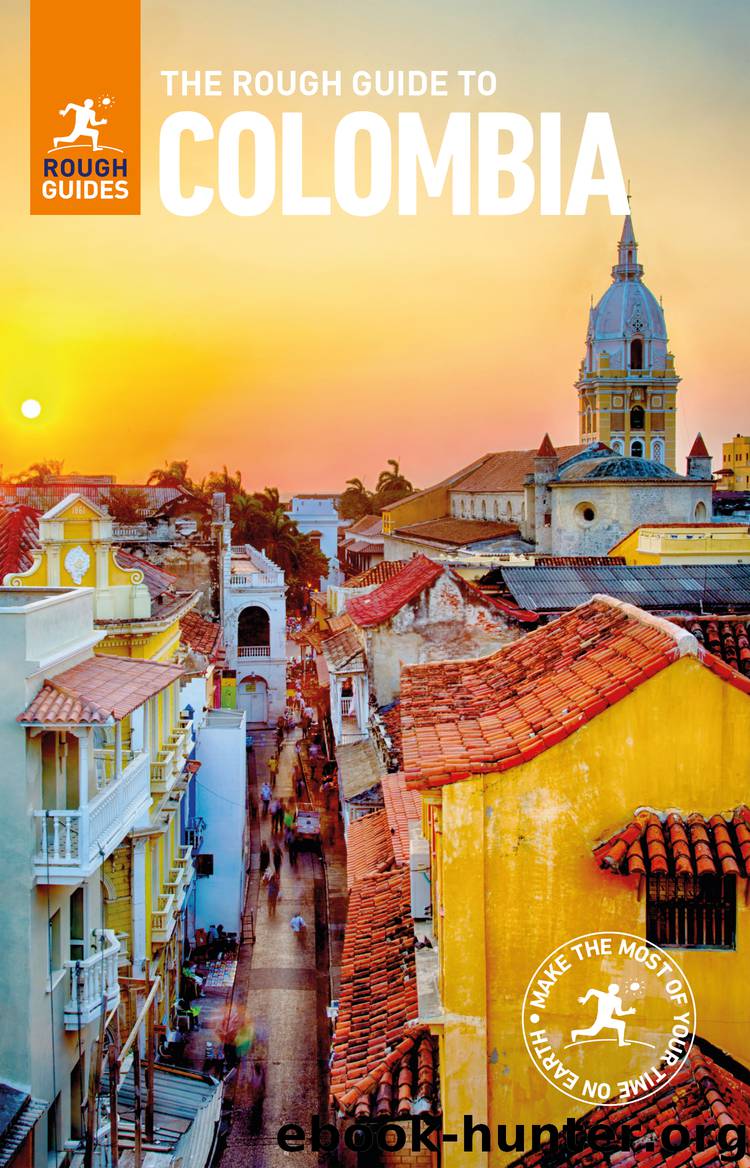The Rough Guide to Colombia by Daniel Jacobs

Author:Daniel Jacobs
Language: eng
Format: epub
Tags: Travel, Colombia
Publisher: Apa Publications
Published: 2018-09-29T10:10:15+00:00
Cueva de Morgan and Pueblito Isleño
Km 7 Crta Circunvalar • Both daily 8.30am–5.45pm • C$15,000 (each site) • 318 548 3468
Halfway up the west coast and just inland (signposted off the coast road), the Cueva de Morgan (Morgan Cave) is a kitsch tourist attraction run by the local Raizal. English-speaking guides will take you around the shady park-like site, beginning with the cave itself (the end of a 200m limestone passage that connects to the sea, said to be one of Captain Morgan’s treasure hideouts). Nearby lies an extremely crude “replica” of Morgan’s ship Sea Wolf, a gallery of local artwork and a Museo del Pirata (Pirate Museum), full of Johnny Depp images and bric-a-brac salvaged from wrecks. Finally, the Museo del Coco (Coconut Museum) contains some truly enormous coconuts (no longer grown here), and endearing sculptures made from coconut shells.
Next door the Pueblito Isleño is a similarly half-hearted attempt to represent traditional Raizal life with wood huts and 35 life-size wood sculptures (hair-braiding, making music, playing dominoes, cooking and the like). The tour guides here can be enlightening, however, if you want to learn about local history.
San Andrés – the ecological threats
Spend any time on San Andrés and it’s obvious that the island is facing some fairly severe ecological challenges. A booming tourism industry and a growing population have put a huge strain on resources, causing pollution and poor waste management; refuse production on San Andrés is more than one hundred tonnes per day. The huge demand for water has led to the over-exploitation of local aquifers and the pollution of both groundwater and coastal waters. Beach erosion is a growing problem, and the island’s waters are heavily fished by industrial ships. Global warming threatens to cause extensive bleaching of the coral reefs, already damaged by pollution, overfishing and hurricanes.
Moving forwards
Part of the challenge has been bringing the locals on board – since the 1960s, the Raizal population has been bypassed by the central government when it comes to development, leading to widespread poverty, a loss of traditional industries and an overreliance on tourism and imports. Locals need to make a living, and resent outsiders lecturing them on how to manage their island – the ongoing dispute over Cayo Bolívar is a sad example.
Since 1993, government-funded CORALINA has been working to reduce pollution in the islands, with some success (see coralina.gov.co), and in 2000, UNESCO declared the San Andrés archipelago a biosphere reserve. The Colombian government established the Seaflower Biosphere Reserve and Marine Protected Area in 2005, while in 2011 the people of the main islands successfully united to stop a proposal to exploit oil in the territory. Beginning in 2017, the local Bajo Tranquilo initiative aimed to deposit more than ten thousand live corals around the islands as a major reef restoration project (volunteers also removed 15 tonnes of rubbish from the surrounding waters by the end of that year).
Download
This site does not store any files on its server. We only index and link to content provided by other sites. Please contact the content providers to delete copyright contents if any and email us, we'll remove relevant links or contents immediately.
Annapurna by Maurice Herzog(3304)
Liar's Poker by Michael Lewis(3230)
A Forest Journey by John Perlin(2925)
Atlas Obscura by Joshua Foer(2708)
The Ogre by Doug Scott(2509)
Cuba by Lonely Planet(2490)
Photographic Guide to the Birds of Indonesia by Strange Morten;(2412)
Tokyo by Rob Goss(2295)
All Things Reconsidered by Bill Thompson III(2266)
The Splendid and the Vile by Erik Larson(2233)
A TIME OF GIFTS by Patrick Leigh Fermor(2103)
INTO THE WILD by Jon Krakauer(2089)
Fatal Storm by Rob Mundle(2084)
Trail Magic by Trevelyan Quest Edwards & Hazel Edwards(2064)
DK Eyewitness Top 10 Travel Guides Orlando by DK(2060)
Abbey in America by Murray John A(2018)
Top 10 Dubai and Abu Dhabi by DK Travel(1994)
Touching the Void by Joe Simpson(1975)
Lonely Planet Australia by Lonely Planet(1974)
